Welcoming Families From Around the World
When children join a new class, they may be nervous and unsure about what to expect. Families want to know if they will be welcome and if the teachers will value their suggestions and appreciate their child.
The family's country of origin of my choice of whom will be entering my classroom is:
Afghanistan
5 ways in which I will prepare to be culturally responsive towards this family:
- Provide warm inviting greetings. Smile while introducing yourself and your colleagues by name. Not only are smiles contagious, but a warm face and voice help children feel safe and show the family that their child’s teachers are caring individuals.
- Create a Welcome Area. Put out a small journal or set up a whiteboard or an easel with paper so current families can write messages to welcome newcomers. The new families can introduce themselves and their children. Add a welcome sign and other decorations that show this is a special day. Include welcome or hello in the languages of all the families in your program.
- Follow each child’s individual schedule for feeling comfortable. Be as flexible as possible during the first few weeks so new children—and their families—can follow their own pace for getting to know the room, the routines, the teachers, and their classmates. Acknowledge children’s strong feelings about being apart from their families or their former teachers. You will be taking the first step toward building relationships based on trust.
- Learn families’ names before the first day. It can be a challenge to memorize the names of all new family members and how they prefer to be addressed. However, it creates a welcoming atmosphere when teachers can greet everyone by name and title
- Display photos of the children and their families. If possible, take photos during an open house or home visits before the first day of school. Or ask families to share some of their own family photos. Post photos on cubbies and at children’s eye level throughout the room. When children see the photos, they can feel connected to their families during the day.

The children and families served in early childhood
programs reflect the ethnic, cultural, and linguistic diversity
of the nation.
The nation’s children all deserve an early
childhood education that is responsive to their families,
communities, and racial, ethnic, and cultural backgrounds.
For young children to develop and learn optimally, the early
childhood professional must be prepared to meet their
diverse developmental, cultural, linguistic, and educational
needs.
Early childhood educators face the challenge of how
best to respond to these needs.
Educators must recognize
that linguistically and culturally diverse children come to early
childhood programs with previously acquired knowledge and
learning based upon the language used in their home.
For
young children, the language of the home is the language they
have used since birth, the language they use to make and
establish meaningful communicative relationships, and the
language they use to begin to construct their knowledge and test
their learning.
The home language is tied to children’s culture,and culture and language communicate traditions, values, and
attitude.
Parents should be encouraged to use
and develop children’s home language; early childhood educators
should respect children’s linguistic and cultural backgrounds
and their diverse learning styles.
In so doing, adults will learn to appreciate the many unique differences and at the same time enhance
children’s learning and development.
References:
https://www.naeyc.org/files/naeyc/file/positions/PSDIV98.PDF
http://www.naeyc.org/tyc/article/welcome-children-and-families-to-your-classroom











